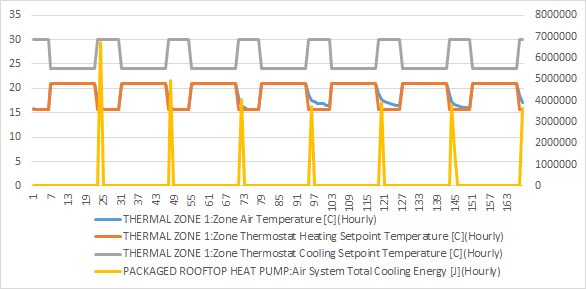 | 1 | initial version |
This is interesting. The interior temperature is tracking the heating set point temperature. There should be no need for cooling, as your well aware. The time of cooling energy coincides with a change in thermostat set point temperature. Create a new plot to see what the program predicts as the zone load with:
OutputVariable,*,Zone Predicted Sensible Load to Heating Setpoint Heat Transfer Rate,detailed;
OutputVariable,*,Zone Predicted Sensible Load to Cooling Setpoint Heat Transfer Rate,detailed;Does your HVAC system use node set point managers? If so, also plot the node temperatures and node set point temperatures.
 | 2 | No.2 Revision |
This is interesting. The interior temperature is tracking the heating set point temperature. There should be no need for cooling, as your well aware. The time of cooling energy coincides with a change in thermostat set point temperature. Create a new plot to see what the program predicts as the zone load with:
OutputVariable,*,Zone Predicted Sensible Load to Heating Setpoint Heat Transfer Rate,detailed;
OutputVariable,*,Zone Predicted Sensible Load to Cooling Setpoint Heat Transfer Rate,detailed;Does your HVAC system use node set point managers? If so, also plot the node temperatures and node set point temperatures.
From the results, it looks to me that the HVAC system is turning cooling on when the heating set point temperature drops from 21C to 15C. This "sort of" makes sense for a single temperature set point, but not for a dual temperature set point. Are you using a "4" (dual set point) for the Control Type in the Thermostat object?

